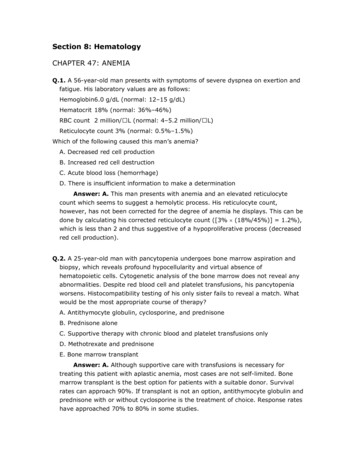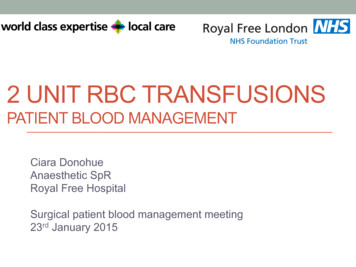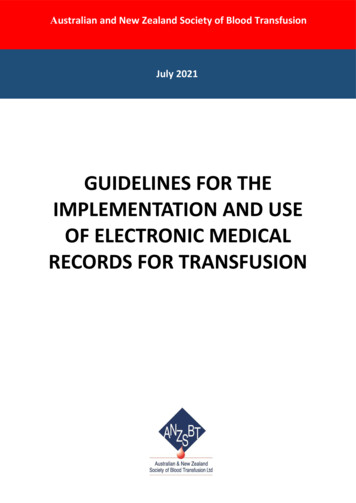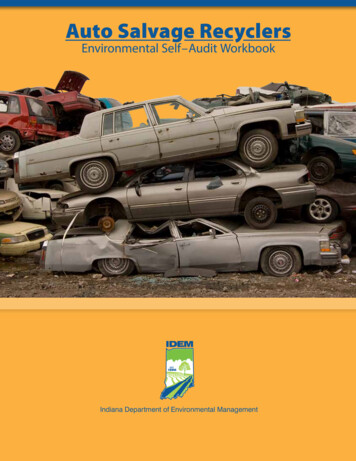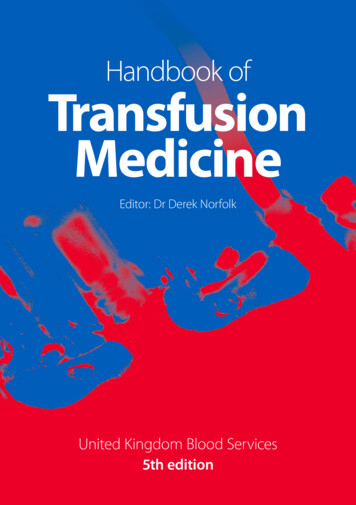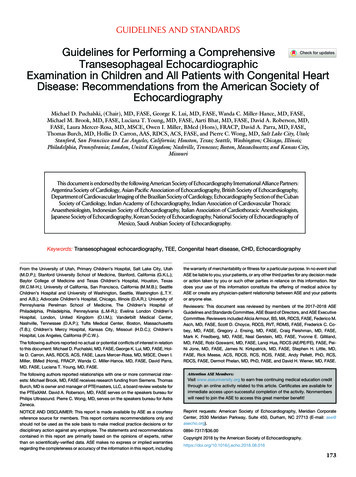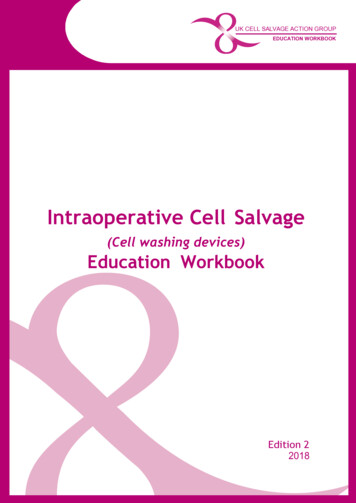
Transcription
UK CELL SALVAGE ACTION GROUPEDUCATION WORKBOOKIntraoperative Cell Salvage(Cell washing devices)Education WorkbookEdition 220181
Trainee DetailsName:Department/Hospital:2
AcknowledgementsThis education workbook has been produced by the UK Cell Salvage Action Group.The images and diagrams in this workbook have been reproduced with the kindpermission of: Medical Illustration Department – Manchester University NHS Foundation Trust Serious Hazards of Transfusion (SHOT) Members of the UK Cell Salvage Action Group Fresenius HemoCare (UK) Limited Haemonetics Limited Sorin Group (UK) Limited Medtronic LimitedThe information contained within this workbook has been sourced from members ofthe UK Cell Salvage Action Group and is generally agreed as ‘good practice’. However,we do not accept any legal responsibility for errors or omissions.3
ContentsSection1235674PageUsing the Education Workbook71.11.289How to use the Education WorkbookAssociated Competency Assessment SkillsTraining Pathway11Basic Blood sFunctions of BloodComposition of BloodCoagulationAllogeneic (Donor) Blood ComponentsRisks of Allogeneic (Donor) Blood TransfusionAllogeneic (Donor) Blood ProductsRecombinant TherapiesBlood Conservation244.1Patient Blood Management (PBM)254.2Reasons for Blood Conservation264.3Autologous Transfusion Techniques264.4Strategies for Blood Conservation274.4.1 Preoperative Strategies284.4.2 Intraoperative Strategies294.4.3 Postoperative Strategies30Haemovigilance335.1Serious Hazards of Transfusion (SHOT)335.2Serious Adverse Blood Reactions and Events (SABRE)37Principles of Intraoperative Cell Salvage396.1Fixed Volume Bowl System406.2Variable Volume Disk System416.3Continuous Rotary System426.4Stages of the Process43Indications and Contraindications477.1Indications and Patient Selection487.2Patient Consent497.3Relative Contraindications, Warnings and Cautions497.4Areas for Further Consideration51
Section8ContentsPracticalities – Blood es – Blood n to Process BloodEquipmentChoice of Bowl SizePreparation of Equipment for Blood ProcessingBlood ProcessingIncomplete BowlsCompleting the ProcessTroubleshootingBlood Loss CalculationsDocumentationPracticalities – on to Collect BloodEquipmentAnticoagulantPreparation of Equipment for Blood CollectionBlood CollectionMaximising Blood CollectionSwab WashingTroubleshootingDocumentationICS (Intraoperative Cell Salvage) End ProductAuthorising ICS BloodEquipmentFiltersReinfusionAdministration of ICS BloodTransfusion ReactionsDocumentationUnloading and 82828385858787878991939396Appendices1234Link to Intraoperative Cell Salvage Competency AssessmentsCell Salvage in Jehovah’s Witness patientsAutologous Transfusion LabelIntraoperative Cell Salvage Data Collection Form1001011041055
Workbook Figures,Tables and GraphsFigurePage1Red Blood Cells, White Blood Cells and Platelets152Blood Separated into its Constituent Parts153The Coagulation Cascade174Strategies for Blood Conservation275Cumulative SHOT Data from 1996 – 2016; n 18,258346SHOT reporting of cell salvage incidents, 2008-2014367Separation of Red Blood Cells in a Fixed Volume Bowl408Variable Volume Disk System419Continuous Rotary System4210Stages of the Process4311Heparin Mechanism of Action6212“Collect Only” Set Up6313Swab Washing6914Estimating Salvaged Blood Volume in the Collection Reservoir7515Movement of Fluid Through the Cell Salvage Machine7716Estimated Blood Loss Calculation8317Haematocrit8618Representation of a Continuous Circuit10219Replacing a Filter Without Breaking Continuity10320Autologous Transfusion Label10421Example of an Intraoperative Cell Salvage Data Collection Form105Graph1Table6TitleTitleChanges in Plasma Haemoglobin from Baseline MeasurementsTitlePage68Page1Properties of the Main Components of Blood142Allogeneic (Donor) Blood Components183Blood Collection Equipment614Blood Processing Equipment765Blood Reinfusion Equipment876Filters for ICS Blood Reinfusion88
Section 1Using the Education WorkbookAim To introduce the learner to the education workbookLearning Outcomes Identify how to use the workbook Identify who the workbook is produced for Identify different learning stylesIntroductionThe aim of this education workbook is to provide learners with the necessaryknowledge to assist them in the safe use of Intraoperative Cell Salvage (ICS) machinesand disposables that wash red cells in the operating theatre and other areas. It shouldbe used in conjunction with practical training covering the following skills: Set up of machines/disposables Processing red cells for reinfusion Reinfusion Disposal of cell salvage wasteThis education workbook has been developed by the UK Cell Salvage Action Group.The group was established to help support the wider implementation of cell salvageas an alternative to allogeneic (donor) blood, and to facilitate a UK-wide approach toits use.This workbook is intended for Doctors, Operating Department Practitioners,Perfusionists, Nurses, Midwives, Health Care Support Workers and all other staffresponsible for the setup and/or running of ICS machines.This workbook does not currently cover any specialised requirements for paediatricpractice.It is essential that all staff involved in the operation ofIntraoperativeCellSalvagemachines are trained to thelevel at which they are expected to operate. Trainingshould include both theory and practice.7
1.1 How to use the Education WorkbookThis publication is designed to be used by the learner as a workbook and oncecompleted can be kept and used for reference.Each section follows the same format and contains the following: Aims Learning Outcomes Subheadings for each “topic”– These will include the body of the text, pictures, and boxes containing informationand best practice guidance/cautions Documentation (if applicable) Key Points Further Reading Self-Directed Learning sectionThe theory component of each section can be accessed as: Face to face training, either classroom style and/or delivered by “key trainers” An e-learning package “Learn Cell Salvage” (available atwww.transfusionguidelines.org.uk) Part of a manufacturer’s training programme A combination of these8
Self-directed learning allows the learner to identify practice within their ownorganisation and reinforces the theory component of each section.In some of the sections the learner will find the following symbols:Relates to information and best practiceCautions: critical points to be aware ofSelf-directed learning questions1.2 Associated Competency Assessment SkillsThis workbook is designed to be used in conjunction with the UK Intraoperative CellSalvage Competency Assessments. The related competency assessments for eachsection are listed in Appendix 1.The ICS competency assessment workbook can be downloaded through the UK CellSalvage Action Group section of the Better Blood Transfusion Toolkit.www.transfusionguidelines.org.uk.9
Self-Directed LearningWho will deliver training and how will it be delivered inyour organisation?Have you accessed the e-learning package Learn CellSalvage at www.transfusionguidelines.org.uk?If yes,identify three key learning points.10
Section 2Training PathwayIntroductionThis education workbook can be used as part of a training pathway. A suggestedpathway designed to offer comprehensive and flexible learning in the use ofIntraoperative Cell Salvage (ICS) is outlined below, followed by an explanation of eachof the stages at the end of this section.Safe Transfusion Practice//Learn Cell Salvage//ICS Education Workbook//Practical Session//Competency Assessment//Maintenance of Case LogsReflective practice should be undertakenat each stage of the training pathway.Date achievedOngoing11
Recognition of the need for safe practice in transfusion isessential. Safe transfusion training should highlight therisks associated with allogeneic (donor) blood transfusionand the importance of the appropriate use of blood.The basics to safe practice in allogeneic blood transfusion are covered in the SafeTransfusion Practice course of Learn Blood Transfusion, an online package aimed atall staff groups involved in the transfusion process. There is an online assessment atthe end of each of the seven modules in this course. A more advanced course,Blood components and Indications for Use, is aimed at members of staff whoauthorize blood and blood components. Learn Blood Transfusion is part of theTransfusion Practice Toolkit (www.transfusionguidelines.org.uk).Learn Cell Salvage is another e-learning course within Learn Blood Transfusion.This course provides you with an introduction to blood conservation in general andICS in particular. An online assessment can be taken at the end of this course.A device-specific practical session on setting up, operating and unloading of the ICSequipment should be undertaken. Training is usually offered by manufacturers but mayalso be delivered by “in-house” trainers.An ICS Competency Assessment Workbook is available to download fromwww.transfusionguidelines.org.uk and has been created based on standardsdeveloped by Skills for Health (PCS 19-22 www.skillsforhealth.org.uk). In-housetrainers may offer competency assessment.The ICS Competency Assessment Workbook also provides the learner with a case logfor recording ICS cases that they have been involved in.12
Section 3Basic Blood FactsAim To introduce the basic concepts of haematology, blood components and bloodproducts and how they interlink with Intraoperative Cell Salvage (ICS) and bloodconservationLearning Outcomes Describe the main functions of blood Identify the main components of blood and describe their individual functions Describe basic coagulation List the allogeneic (donor) blood components available for clinical use Identify the allogeneic (donor) blood products available for clinical use Identify the recombinant therapies available for clinical useIntroductionBefore considering ICS it is important to understand the composition and function ofwhole blood as well as the functions of the main components of blood and howthese components can be separated.3.1 Functions of BloodHuman blood is a collection of cells suspended in liquid and has the followingdefinable functions: Transport:– Dissolved gases (e.g. oxygen, carbon dioxide)– Waste products of metabolism (e.g. water, urea)– Hormones, enzymes and nutrients– Plasma proteins (associated with defence, such as blood clotting andantibodies)– Blood cells (including white blood cells and red blood cells) Maintenance of body temperature Control of pH:– The pH of blood must remain in the range 6.8 to 7.4 otherwise cells becomedamaged Removal of toxins from the body:– The kidneys filter all of the blood in the body (approximately 8 pints), 36 timesevery 24 hours. Toxins removed from the blood by the kidneys leave the bodyin the urine. Toxins also leave the body in the form of sweat. Regulation of body fluid electrolytes:– Excess salt is removed from the body13
3.2 Composition of BloodBlood has both cellular and non-cellular components, each accounting forapproximately half of the total volume. The cellular components, which areproduced in the bone marrow, include red blood cells (RBCs), white blood cells(WBCs) and platelets. The non-cellular component of blood is plasma which isprimarily water. Plasma contains proteins such as albumin, clotting factors,immunoglobulin and electrolytes. Blood constitutes about 7% of body weight, whichis 70ml/kg.Haemoglobin (Hb) is a complex protein-iron compound in the blood that carriesoxygen to the cells from the lungs and carbon dioxide away from the cells to thelungs. Each red blood cell contains 200 to 300 million molecules of haemoglobin.Each molecule of haemoglobin contains several molecules of haem, each of whichcan carry one molecule of oxygen. The normal concentration of haemoglobin isbetween 125 and 160g/l.Haematocrit (Hct) is a measure of the number of red cells found in the blood, statedas a percentage of the total blood volume. The normal range is between 43 and49% in men and between 37 and 43% in women.Table 1. Properties of the Main Components of BloodPropertiesRed Blood CellsWhite Blood CellsPlateletsSize7 microns7 – 20 microns2 – 5 micronsSurvival120 daysHours – few days5 – 9 daysNormal ranges*4.5 – 5.8 million5,000 – 10,000150,000 – 400,000FunctionTransport of O2Immune response,fight infectionClotting*Normal ranges will vary according to age and gender and also depending on thetechnology used to measure the cells.14
Figure 1. Red Blood Cells, White Blood Cells and PlateletsBecause the components of blood have different densities, if they are allowed to settlein a test tube or spun in a centrifuge, they will separate according to their densities(Figure 2).Figure 2. Blood Separated into its Constituent Parts15
3.3 CoagulationThe clotting cascade is initiated by either the intrinsic or extrinsic pathway bothleadingto a series of coagulation events. The intrinsic pathway is initiated when bloodcomes into contact with a foreign (non-endothelial) surface such as tissue grafts orartificial heart valves, or when blood is removed from the body. The extrinsicpathway is normally activated by an external tissue injury such as a cut or rupturedvessel. Regardless of the origin, an amplification of the coagulation process leads toa common pathway where fibrinogen is converted to fibrin. During surgicalprocedures both the intrinsic and extrinsic pathway are stimulated.Coagulation tests The APTT is a test of the intrinsic pathway of coagulation. (Activated PartialThromboplastin Time (APTT, KCCT, PTTK, KPTT, PTT)). All the aboveabbreviations refer to the same test and terminology varies between laboratories. The PT tests the extrinsic pathway of coagulation (One Stage Prothrombin Time(OSPT, PT)). TEG /ROTEM are tests of whole blood coagulation measuring the viscoelasticproperties of the developing blood clot. These tests can be performed near to thepatient i.e. they are Point of Care Tests (POCT). Platelet function tests (e.g. Platelet mapping , Multiplate , Verifynow ) measurethe effect of platelet inhibitory drugs on platelet function.16
Figure 3. The Coagulation alChemistry1)17
3.4 Allogeneic (Donor) Blood ComponentsAll blood components in the UK are collected from blood donors who are unpaidvolunteers. They are very carefully selected and tested to make sure that the bloodthey donate is as safe as possible. Compared to other everyday risks, the likelihoodof getting an infection from a blood transfusion is very low. All units supplied in theUK are leucodepleted (white blood cells removed) and have been since 1999 as aprecaution against variant Creutzfeldt-Jakob Disease (vCJD), with the exception ofGranulocytes, which are the white blood cells. Table 2 lists the blood componentsavailable for clinical use.Table 2. Allogeneic (Donor) Blood ComponentsComponentRed cellsVolumeStorage220-340ml Designated temperaturecontrolled fridge 2-6ºC.Shelf life: 35 days.PlateletsApheresis 199mlPooled 300mlTemperature controlled‘room temperature’ (2024ºC) - gentle agitation topromote gaseousexchange.Shelf Life: 5-7 days.The prevention and treatment ofbleeding due to: Thrombocytopenia associated withlarge volume blood transfusions. Consumption due to disseminatedintravascular coagulation (DIC),major surgery. 274mlDesignated temperaturecontrolled freezer -25ºC.Shelf life: 36 months (24hours at 4ºC afterthawing). Clinically abnormal haemostasisfollowing massive blood transfusionor major surgery. Multiple coagulation factordeficiencies and disseminatedintravascular coagulation (DIC). Haemostatic defects associated withliver disease if bleeding/invasiveprocedure.Cryo-precipitateSingle 43mlDesignated temperaturecontrolled freezer -25ºC.Pooled 189mlShelf life: 36 months (usewithin 4 hours of thawing,do not refrigerate).Bleeding associated withhypofibrinogenaemia. This mostcommonly occurs in: DIC massive transfusion advanced liver disease.Single 40-70mlPooled 207ml18To raise the oxygen-carrying capacityof the blood when it is symptomaticallyreduced due to red cell loss or reducedred cell production.Fresh frozenplasma**Patients born onor after 1 January1996 should onlyreceive plasmasourced fromcountries with alow risk of vCJD.GranulocytesClinical indications in thesurgical settingTemperature controlled‘room temperature’ (2024ºC).Shelf-life: 24 hours.Patients with/at high risk of developinglife-threatening bacterial or fungalinfection secondary to neutropeniacaused by bone marrow failure orneutrophil dysfunction.
3.5 Risks of Allogeneic (Donor) TransfusionIt is rare for someone to develop a viral infection from a blood transfusion, as theblood services use strict testing processes, however there will always be a small riskof this. The risk of getting vCJD from a blood transfusion is extremely low with a singleblood transfusion, but the risk of any infection will increase with additional bloodtransfusions. . One of the biggest risks is from getting the “wrong blood” asevidenced by the Serious Hazards of Transfusion (SHOT) annual reports2.Blood and blood components must always be storedunder controlled storage conditions in designatedfridges, freezers, and agitators.3.6 Allogeneic (Donor) Blood ProductsHuman Albumin 4.5%4.5 % human albumin is iso-oncotic with human plasma. It is usually supplied in a400ml bottle which is stored at room temperature. The dosage should reflectcirculating blood volume, rather than measures of albumin levels, and will varyaccording to patient size and the severity of the illness or fluid/protein losses. It isusually administered through a standard infusion set at rates of 5-15ml per minute,although this varies according to clinical need.There is no firm evidence that the use of colloids, including albumin, isadvantageous over the use of balanced crystalloid solutions for fluid resuscitation inpatients with trauma, burns or following surgery3.Simply raising a patient’s albumin level does not improveoutcome and other fluids may be effective for raisingblood pressure: e.g. balanced crystalloid solutions19
Human Albumin 20%20% albumin has an oncotic pressure approximately 3-4 times higher than that ofnormal human plasma and infusion will therefore expand plasma volume by drawingin extravascular fluid. It is supplied in 100ml bottles and again is infused through astandard infusion set at rates of 1-2ml per minute.20% albumin solutions are used in the management of: Hypoproteinaemic oedema associated with nephrotic syndrome (diureticresistant oedema) Ascites in liver diseaseImmunoglobulin ProductsImmunoglobulins are the antibodies produced by B-lymphocytes in response toinfection. Immunoglobulins are important for the correct functioning of the immunesystem, fighting bacterial infections, neutralising viruses and activating thecomplement systems.Fractionated Plasma DerivativesFractionated plasma derivatives such as prothrombin complex concentrate(combined Factor II, VII, IX, X concentrates), fibrinogen concentrate and othersingle Factor concentrates (e.g. Factor VIII or IX) are used in the management ofboth hereditary and acquired clotting disorders.3.7 Recombinant TherapiesRecombinant Clotting FactorsRecombinant clotting Factors VIII and IX are used as a treatment for people withHaemophilia A and B, respectively.Allogeneic blood products fall under the Human Medicines Regulations (2012), areclassed as medicines and must be prescribed.Allogeneic blood components do not fall under these regulations, are not classed asmedicines and do not need to be prescribed, but must be authorised by anappropriately qualified healthcare professional.20
Key Points Red cells are the heaviest component of blood and it is this property that allowsthe separation of washed red cells from the waste products in ICS. Heparin and citrate both inhibit coagulation and this allows for blood to becollected without clotting. Allogeneic blood and blood components are extremely safe and the greatest riskis in giving the wrong blood.References1. AnaesthesiaUK. Coagulation – classical model d 1000962. Serious Hazards of Transfusion (1996 – 2016) Annual Reports www.shotuk.org3. Perel P, Roberts I, Ker K. Colloids versus crystalloids for fluid resuscitation incritically ill patients. Cochrane Database Syst Rev. 2013 Feb; 28;2:CD000567Further Reading Hoffbrand’s Essential Haematology (Essentials), V. Hoffbrand and P Moss(2015) (ISBN- ‐13:978- ‐1118408674) ABC of Transfusion (ABC Series), Marcela Contreras (2009) (ISBN10- ‐1405156465) Handbook of Transfusion Medicine, 5th Edition edDNorfolk(2013)(ISBN9780117068469)21
Self-Directed LearningWhat are the normal ranges for Haemoglobin (Hb),Haematocrit (Hct), and platelets in your hospital?What are the normal ranges for Prothrombin Time (PT),Activated Partial Thromboplastin Time (APTT) andFibrinogen in your hospital?22
What allogeneic blood components are available fromyour blood transfusion laboratory?What allogeneic blood products are available in yourhospital?23
Section 4Blood ConservationAim To introduce the learner to the basic concepts of blood conservationLearning Outcomes Identify the principles of blood conservation Identify the areas where blood conservation can be undertaken in surgicalpatients Describe the main strategies of blood conservationIntroductionAllogeneic (donor) blood is a valuable but limited resource and although potentiallylife-saving, is not without risks e.g. wrong blood incidents, transmission of infectionand immunosuppression.Concerns over a future blood shortage, have resulted in increased efforts tomanage the blood supply more effectively.Reducing the demand (blood conservation) takes many forms and can occur in bothmedical and/or surgical patients. Blood conservation strategies are a majorcomponent of Patient Blood Management, particularly in the surgical setting.24
4.1 Patient Blood Management (PBM)Patient Blood Management is a multidisciplinary, evidence-based approach tooptimising the care of patients who might need blood transfusion. Patient BloodManagement puts the patient at the heart of decisions made about bloodtransfusion to ensure they receive the best treatment and avoidable, inappropriateuse of blood and blood components is reduced.In June 2012 a panel of experts and influencers in the field were invited to a oneday conference in order to consider international best practice and what can bedone to ensure a Patient Blood Management approach is adopted across Englandand North Wales.The aim of the multi-disciplinary conference was to share views on how bloodtransfusion practice could be improved to: Build on the success of previous Better Blood Transfusion initiatives and tofurther promote appropriate use of blood components. Improve the use of routinely collected data to influence transfusion practice. Provide practical examples of high quality transfusion practice and measures forthe avoidance of transfusion, wherever appropriate. Consider the resources needed to deliver better transfusion practice includingsupport from NHSBT. Understand the patient perspective on transfusion practice.Following this conference an initial series of recommendations1 were published bythe National Blood Transfusion Committee supported by NHS England and NHSBlood and Transplant in June 2014.A copy of these recommendations can be found ttee/patient-blood-managementA toolkit to assist NHS Trusts is being developed and posted on the NBTC ansfusion-practice25
4.2 Reasons for Blood ConservationConcerns over possible future blood shortages have resulted in increased efforts tomanage the blood supply more effectively. This includes efforts to increase thesupply and to reduce the demand for blood. Reducing the demand (bloodconservation) takes many forms and can occur in both medical and/or surgicalpatients. This section focuses on surgical patients.Autologous blood transfusion is one of many bloodconservation strategies which should be considered whendeveloping a blood conservation programme.Emergency Plans for Blood ShortagesBlood services and the hospitals across the UK have made plans to manage thesupply of blood in the event of a prolonged shortage. The UK blood services andhospitals have a responsibility to develop an integrated Emergency BloodManagement Plan to ensure shortages are handled in a fair way and, onceimplemented, will invoke a controlled response to a shortage situation. For thisreason, efforts at better and more appropriate management of the blood supply arebeing advocated.4.3 Autologous Transfusion TechniquesThe following techniques involve the collection and reinfusion of the patient’s ownblood or blood components.Preoperative Autologous Donation (PAD)PAD is a form of autologous transfusion where blood is collected from the patient,stored and reinfused at surgery, if appropriate.Preoperative Autologous Donation (PAD) is currentlyonly recommended in exceptional circumstances.Preoperative Autologous Donation prior to planned surgery has been usedextensively in the USA. In practice the patient goes to theatre with a lower thannormal Hb and there is no evidence that these patients receive any less allogeneic(donor) blood, so this technique is no longer recommended as routine. In rare casesof unusual antibody formation or in a situation of blood shortage, it may beconsidered but it can only be carried out in premises licensed by the Medicines andHealthcare products Regulatory Agency (MHRA) as a blood establishment.26
Acute Normovolaemic Haemodilution (ANH)This is a procedure where the patient donates their own blood in the anaestheticroom with full monitoring in place. At the same time, a plasma expanding fluid isinfused to maintain the circulating volume. The patient’s whole blood is collected,labelled and kept by the patient’s side, then reinfused when surgical bleeding hasceased.Acute Normovolaemic Haemodilution (ANH) is not currentlyrecommendedAdverse events include myocardial ischaemia, pulmonary oedema and misidentification of blood. A meta-analysis2 suggested only modest benefits andtherefore this technique has limited benefit.Intraoperative Cell Salvage (ICS)ICS is used during surgery to collect whole blood which would otherwise be lost.Most systems then concentrate and wash the red cell component before reinfusionback to the patient.Post-operative Cell Salvage (PCS)Generally used in orthopaedic surgery, blood that is lost from the wound postoperatively is collected into special autologous wound drains where it is filteredbefore being reinfused to the patient. There are also machines available that extendthe intraoperative cell salvage process into the post-operative period providingwashed red blood cells for reinfusion.4.4 Strategies for Blood Conservation in surgical patientsFigure 4. Strategies for Blood ConservationStrategies for Blood iveMaximum Surgical BloodOrder scheduleCell salvageMinimize blood lossAnaesthestic techniqueCell salvageAssessment clinicsNormothermiaTransfusion thresholdsIronTranexamic acidErythropoetinSurgical techniqueReview requirement fortransfusionHaemostats and sealantsIronPoint of care testsErythropoetin27
4.4.1 Preoperative StrategiesMaximum Surgical Blood Order Schedule:A maximum surgical blood order schedule (MSBOS) is an agreed number of unitsof blood (red cells) that will be cross-matched for a patient undergoing a specificsurgical procedure. MSBOS reduces excessive requesting of blood. These daysmany surgical procedures have no units listed in an MSBOS and rely simply on avalid group and save sample which may be used to issue group-specific or crossmatched units on request.Assessement Clinics (Preoperative Planning)- Manage Hb (correct anaemia)- Manage haemostasis (detect and manage coagulation disorders, stop anticoagulants and anti-platelet drugs if safe to do so)- Cell salvage (arrange for blood salvage to be available if it is appropriate for theplanned surgery, ensuring availability of kit and operator)- Discuss potential need for transfusion and possible alternatives with the patient.Iron:Iron supplements are usually used to treat iron-deficiency anaemia. It is alsocommon to administer supplements to individuals who are not anaemic but whohave evidence of absent body iron stores. Iron can be an oral or intravenouspreparation.Oral IronOral iron is available in a variety of preparations and is the recommended treatmentfor mild to moderate iron deficiency anaemia. The recommended dose is 80-100mgelemental iron per day but compliance is often poor because of gastrointestinal sideeffects. Oral iron therapy may fail in the presence of chronic diseases, e.g. Crohn’s,ulcerative colitis, coeliac disease, renal failure, parasitic disease, and drugs thatinhibit erythropoiesis (red blood cell production).NICE guidance on blood transfusion (2015) recommended that oral iron be offeredbefore and after surgery to patients with iron deficiency anaemia.Intravenous (IV) IronThis is an alternative to oral iron and may be required if there is insufficient or noresponse to oral iron, intolerance of oral iron, severe anaemia or a need for a rapidresponse. IV iron should only be administered if the patient’s iron status is known, toprevent iron overload.28
NICE guidance recommends:Consider intravenous iron before or after surgery for patients who:- Have iron d
6!! Workbook Figures, Tables and Graphs !!! Figure Title Page 1 Red Blood Cells, White Blood Cells and Platelets 15 2 Blood Separated into its Constituent Parts 15 3 The Coagulation Cascade 17 4 Strategies for Blood Conservation 27 5 Cumulative SHOT Data from 1996 - 2016; n 18,258 34 6 SHOT reporting of cell salvage incidents, 2008-2014 36 7 Separation of Red Blood Cells in a Fixed Volume .
